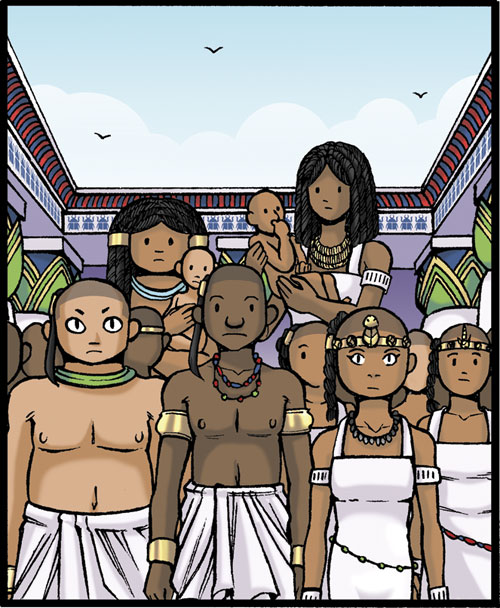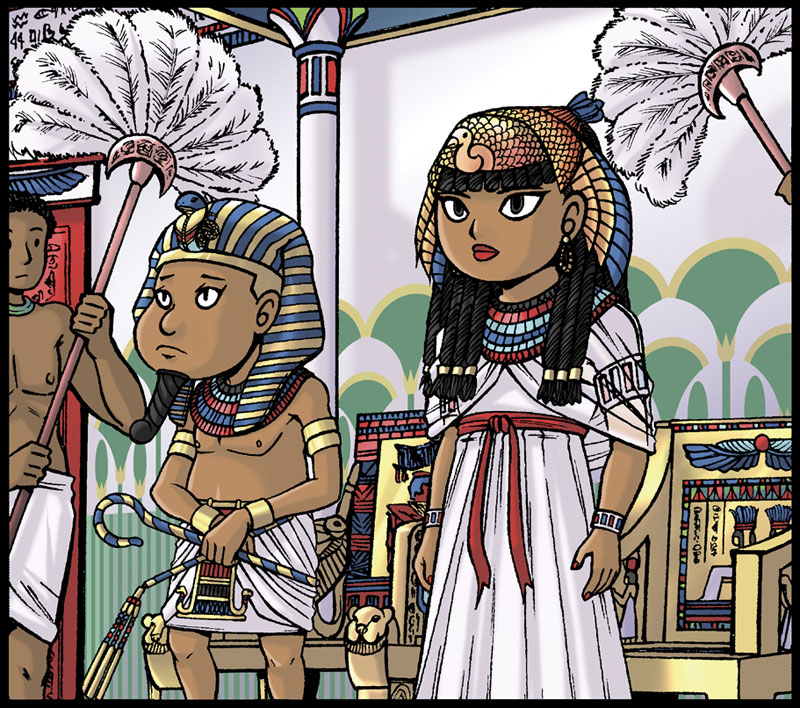
This is from my “Greatest Queens of History: Hatshepsut” story, which has been scripted to be 30 pages. I spent a fair amount of time doing research on Egypt, the New Kingdom (18th Dynasty, which is approx 1550BC – 1292BC) and Hatshepsut herself, so I’ll list my sources below and what I had to consider when I put this picture together.
Note: Much of my visual sources are not from Hatshepsut’s reign itself, because her tomb and the tombs of Thutmose 1-3 has been grave robbed, and no funerary items from it survive. So when I draw on visual sources for this story, I tried to use sources from the same 18th Dynasty, A fair amount of it came from the tomb of King Tutankhamun, or Amenhotep III.
- Hatshepsut and Thutmose II are depicted here as Pharaoh and Pharaoh’s Great Wife, both in ceremonial dress for this part of their coronation ceremony. The coronation ceremony is a long, ritualistic affair that takes days, and none of this is depicted here because we know very little about it. They ascended to the throne young, so they’re depicted as children here.
- Thutmose II is wearing the Pharaoh’s Nemes headdress, false beard and holding the symbolic crook and flail, while Hatshepsut is wearing the Great Wife’s vulture headdress. Both are also wearing the broad collar necklace, which like the headdresses is a ceremonial thing. Neither of them would have wandered the palace dressed in this manner on a normal day. Both would have worn eyeliner though.
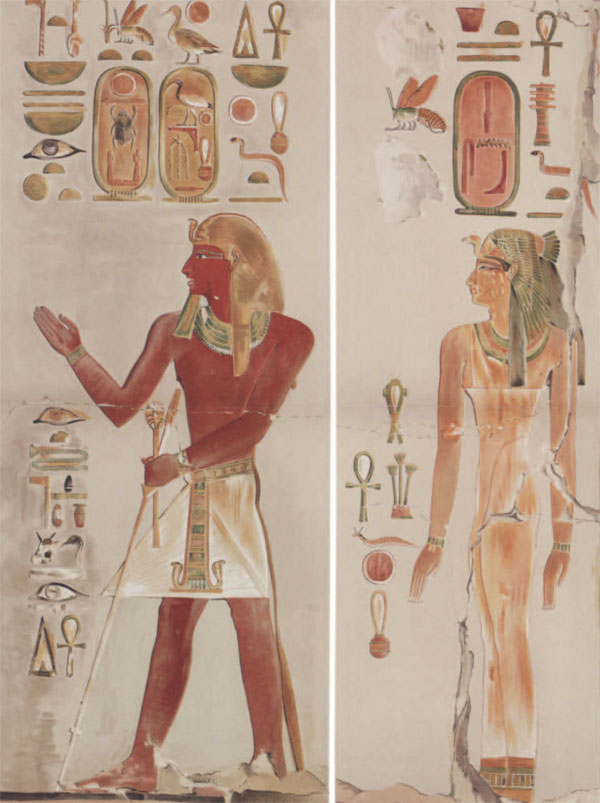
Thutmose I and his mother. Wall painting from the upper Anubis chapel of Hatshepsut’s temple at Deir el-Bahri, early 18th Dynasty. Source: Roehrig, Catherine H. et al. “Hatshepsut: From Queen to Pharaoh”. PG 8.
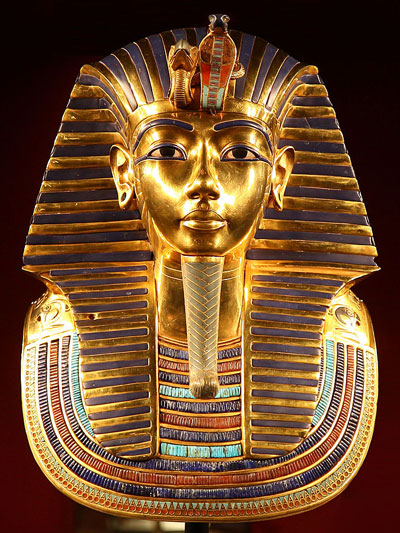
King Tutankhamun’s death mask, which has the unusual double uraeus of a cobra and a vulture. Typically, it’s just a cobra.Source: Wikipedia
- The two throne are based off the throne of Tutankhamun for Thutmose II, and the throne of Princess Sitamun, daughter (and eventual wife) of Amenhotep III. Both of these are funerary items, but it’s safe to assume that they were used in the Pharaoh’s life, though funerary items aren’t necessarily everyday items for Ancient Egyptians.
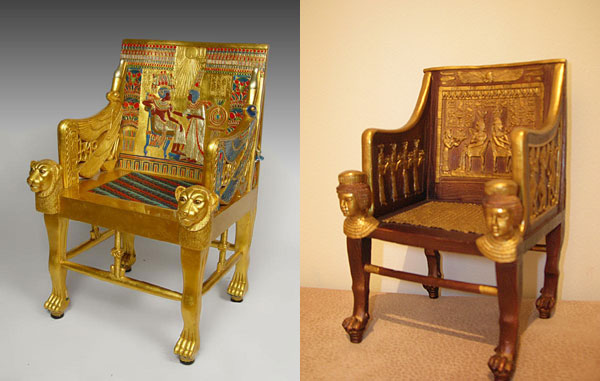
Replicas of Tutankhamun’s throne on the left, and Princess Sitamun’s throne on the right. Souce: Wikipedia
- The throne is on a raised dais which has several steps, which can’t be seen here. The dais has a kiosk thing over it, which is depicted here – it should have cartouches of the Pharaoh’s name and scarab beetles on it, though we can’t know for sure.
- The servant holding the ostrich feather fan has real hair. Servants were not allowed to shave their hair and wear wigs – that was reserved for the upper classes. Hatshepsut may well have been bald because she would have worn elaborate wigs.
- The wall paintings are of waterlilies, which grow along the Nile River. Since the palace from Thutmose I’s time didn’t survive, we have little idea of what the throne room would have been like. It’s safe to assume that the walls are white-washed, and painted with images of Egyptian flora and fauna. In this instance, I thought it best to keep the throne room neutral, with references to the Nile (considered the source of all Egyptian life) rather than to any fauna, since different animals have different connotations in Egypt.
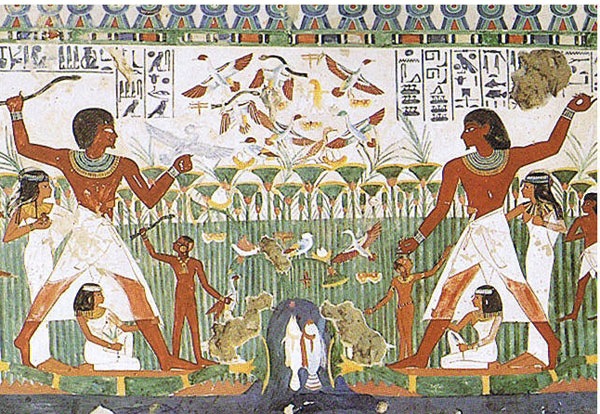
This is from the tomb of Nakht, which is known as Theban Tomb TT52, part of the Theben Necropolis. This appears to be an Egyptian official, and I copied the background from this tomb image. Source: Wikipedia
This is Page 1, Panel 3, showing the group of children from Thutmose I’s harem. To be honest, these children should all be naked, since it’s considered perfectly acceptable for Egyptian children of a certain age, whether male or female, to run around naked. I don’t feel comfortable depicting naked children though, so I thought I’d put generic clothes on them. The girls are wearing diadems and girdles, and both boys and girls have shaven heads with locks of hair on the side, which is to prevent lice.
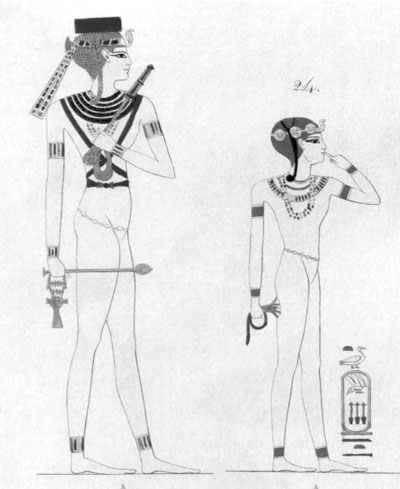
Two young princesses, Nefrure and Nefrubiti, wearing elaborate sets of jewelry, including diadems and girdles. Painted reliefs from Hatshepsut’s temple at Deir el-Bahri, early 18th Dynasty. Source: Roehrig, Catherine H. et al. “Hatshepsut: From Queen to Pharaoh”. PG 202.
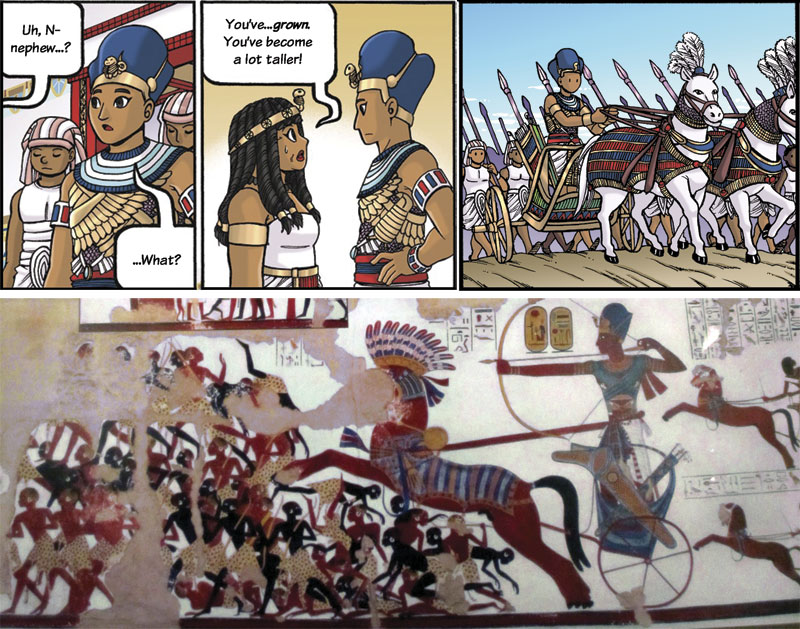
- Here’s Thutmose III in his blue war crown and pharaoh’s war armour. Thutmose III was unlikely to have strutted about his palace in that outfit, which is why he later switches to a plain kilt and diadem when playing field hockey.
- The above relief is from temples built by Ramesses II at Beit-el Wali, and shows Ramesses II, also known as Ramesses the Great, charging the Nubians. He was a 19th Dynasty pharaoh who came after Hatshepsut, but the pharaoh’s blue war crown, armour and chariot depicted is unlikely to have changed much from earlier times.
Visual Sources
- Cooney, Kara. “The Woman Who Would be King: Hapshetsut’s Rise to Power in Ancient Egypt”. USA: Crown Publishers, 2014.
- Hope, Colin A. “Gold of the Pharaohs”. Australia: Museum of Victoria, 1988.
- Roehrig, Catherine H. et al. “Hatshepsut: From Queen to Pharaoh”. USA: The Metropolitan Museum of Art, 2006.
- Galford, Ellen. “Hatshepsut: The Girl Who Became a Great Pharaoh”. United States: The National Geographic Society, 2005.
- Shaw, Garry J. “The Daily Life of a Pharaoh”. Dr Gary J. Shaw. Al Rawi: Egypt’s Heritage Review, issue 5, 2013. Web. 7 Sep. 2017.

